This site uses only a few technical cookies necessary for its operation. By continuing to browse, you accept their use.
To find out more...
To find out more...
Leavened bread

It might be harder to achieve good results than with traditional yeast bread, but what a flavour! It also keeps better.
This recipe is designed for baking bread in a wood-fired oven but, of course, you can use the conventional oven in your kitchen.
This recipe is designed for baking bread in a wood-fired oven but, of course, you can use the conventional oven in your kitchen.
Last modified on: May 23th 2017
For 2 loaves, you will need:
- 1
 300 g leaven
300 g leaven - 2
 1 kg plain white flour (French Type 65)
1 kg plain white flour (French Type 65) - 3
 18 g salt
18 g salt - 4
 440 ml water
440 ml water - 5
 1 g yeast (optional)
1 g yeast (optional) - Total weight: 1,760 grams
Times for this recipe
Preparation: 40 min.
Resting: 5 hours 10 min.
Cooking: 40 min.
All in all: 6 hours 30 min.
If you start now, at , you will finish around : ?.Change start time
To finish around 7pm, you'll need to have started before: .Change end time
Step by step recipe
Stage 1 - ⌛ 5 min.
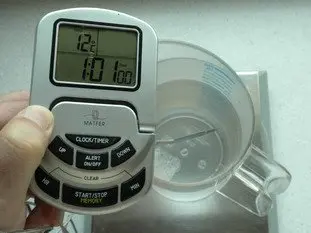
In bread-making, the water temperature is always important. It's not a fixed value, but related to 3 other temperatures: 1) the temperature of your flour, 2) the room temperature in your kitchen, and 3) the Basic temperature in bread-making of this recipe, which is 56-62°C.
You can calculate the temperature of the water for this recipe in one click, using this small calculator.
You can calculate the temperature of the water for this recipe in one click, using this small calculator.
Stage 2 - ⌛ 10 min.
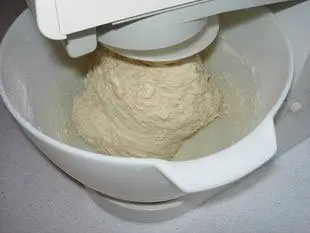
Put into a food-processor bowl: 300 g leaven, 1 kg plain white flour (French Type 65), 18 g salt, 440 ml water at the right temperature, and 1 g yeast.
Then knead on minimum speed for 3 minutes, and 3 further minutes a little faster (speed "1").
Note: For the best way to knead, see: A few tips for effective kneading at home.
Then knead on minimum speed for 3 minutes, and 3 further minutes a little faster (speed "1").
Note: For the best way to knead, see: A few tips for effective kneading at home.
Stage 3 - ⌛ 10 min.
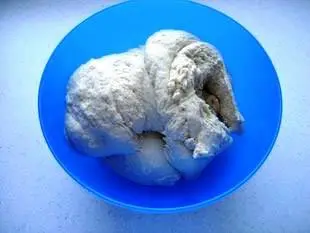
Transfer the dough into a clean bowl, or leave it in the mixer bowl, and cover with a plastic sheet.
It needs to rest for approximately 10 minutes.
It needs to rest for approximately 10 minutes.
Stage 4 - ⌛ 3 min.
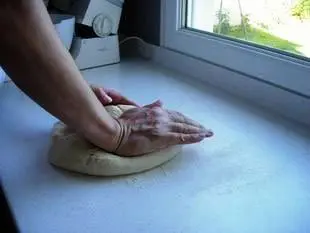
At the end of this time, tip the dough onto the work surface.
You now need to "structure" or work the dough to obtain a beautiful even ball from this heap of dough. The ball should have a well rounded top and a base which is called the seam, where the folds join.
To achieve this, fold the sides of the dough into the centre, using the heel of your hand. This first stage kneading (a lighter touch than for hard-wheat dough) French bakers call "frasage".
You now need to "structure" or work the dough to obtain a beautiful even ball from this heap of dough. The ball should have a well rounded top and a base which is called the seam, where the folds join.
To achieve this, fold the sides of the dough into the centre, using the heel of your hand. This first stage kneading (a lighter touch than for hard-wheat dough) French bakers call "frasage".
Stage 5
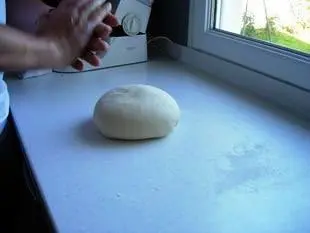
Continue until you get a nice even ball.
Stage 6 - ⌛ 3 hours
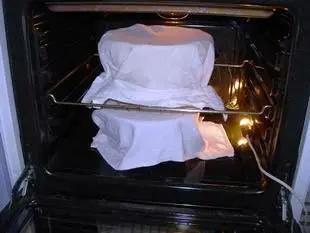
Then put the ball of dough into a bowl, with the seam underneath, and cover with a plastic sheet.
Leave to rise in a warm draught-free place, for approximately 3 hours, this first rising is the "pointage" (starting) in French.
Leave to rise in a warm draught-free place, for approximately 3 hours, this first rising is the "pointage" (starting) in French.
Stage 7 - ⌛ 5 min.

At the end of this time transfer the dough onto the work surface and "knock back", i.e. remove the CO2 which forms during rising and which gives the honeycomb structure to the dough (the spaces in the cooked crumb).
The best way to do this is to press gently on the dough with your hands to crush out the gas bubbles (you may well hear "pschhh" as the gas escapes).
The best way to do this is to press gently on the dough with your hands to crush out the gas bubbles (you may well hear "pschhh" as the gas escapes).
Stage 8 - ⌛ 5 min.
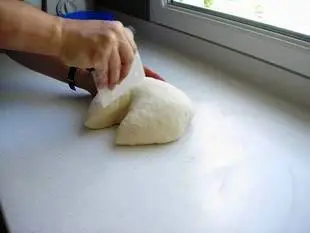
Then cut the dough into lumps the size or the weight of your choice, and shape the loaves.
The photo shows 2 loaves of approximately 800 g, but with this amount of dough you could make one large round loaf.
The photo shows 2 loaves of approximately 800 g, but with this amount of dough you could make one large round loaf.
Stage 9 - ⌛ 5 min.
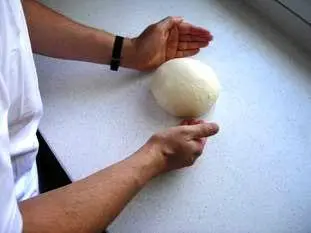
With each lump, reshape into a ball with a rounded top and seam underneath, always gently, to preserve the honeycomb structure of the bread, by folding the dough towards the underside.
Eventually you should get beautiful round shapes again.
For round loaves the shaping is now complete.
Eventually you should get beautiful round shapes again.
For round loaves the shaping is now complete.
Stage 10 - ⌛ 3 min.
You can make long loaves, ("batards" or bastards in French!) rather than round ones.
For this, turn the ball over and roll it up on itself while at the same time rolling it on the work surface.
Foot-note: It's a difficult action to describe, so you can watch it in the short video on the right.
For this, turn the ball over and roll it up on itself while at the same time rolling it on the work surface.
Foot-note: It's a difficult action to describe, so you can watch it in the short video on the right.
Stage 11
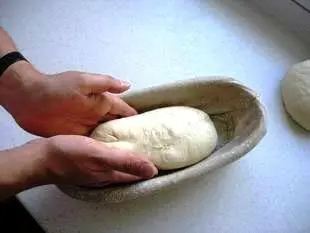
Place your loaves (gently and with much love) into floured rising baskets (bannetons).
Note: the smooth face which will be the top of the bread should be placed downwards, and the seam on top, because the loaves will be turned over before putting in the oven.
Note: the smooth face which will be the top of the bread should be placed downwards, and the seam on top, because the loaves will be turned over before putting in the oven.
Stage 12 - ⌛ 2 hours

Cover with a plastic sheet, and put in a warm place again for 2 hours. In French this second rising is called "l'appret" (finishing).
Stage 13

Preheat your oven at 460°F (240°C).
When the dough is ready (well risen), it's time to bake.
Flour the peel (bread oven "shovel") and the surface of the loaf, then turn it out onto the peel.
You can also put the peel on top of the bread, and turn the whole lot over in a smart but smooth action. Then remove the basket.
If you are baking in your kitchen oven, put the loaf on a baking sheet.
When the dough is ready (well risen), it's time to bake.
Flour the peel (bread oven "shovel") and the surface of the loaf, then turn it out onto the peel.
You can also put the peel on top of the bread, and turn the whole lot over in a smart but smooth action. Then remove the basket.
If you are baking in your kitchen oven, put the loaf on a baking sheet.
Stage 14
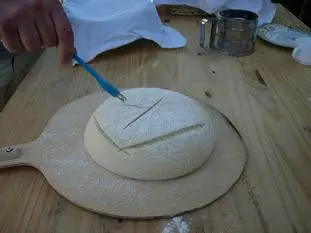
Slash the top of the loaf with a sharp blade. In French this is "le lamage", then put in the oven immediately.
Stage 15 - ⌛ 40 min.
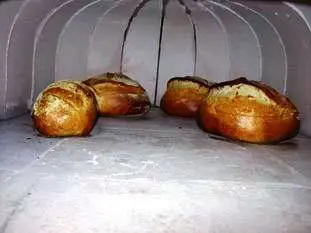
Cook for about 40 minutes.
Note: As when baking any bread, you should ensure that the oven is filled with steam for the first 15 minutes of baking. This page shows you how; it really is the secret of golden-brown, crusty loaves.
Note: As when baking any bread, you should ensure that the oven is filled with steam for the first 15 minutes of baking. This page shows you how; it really is the secret of golden-brown, crusty loaves.
Stage 16
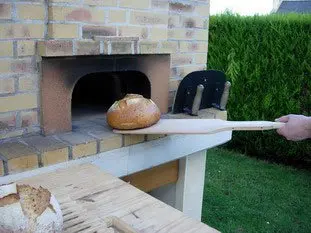
Removing the baked loaves from the oven is always a magical moment (at least when it works, otherwise it's a drama...).
The golden loaves crackle delightfully while cooling ...
The golden loaves crackle delightfully while cooling ...
Stage 17
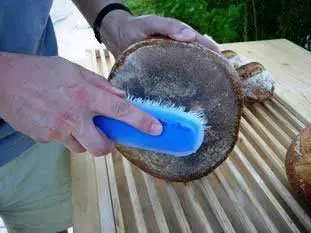
When the loaves have cooled slightly they should be brushed on the underside to remove surplus flour, and the inevitable bits pieces of charocal and ash (I love this moment!).
Stage 18

That's it, finished, now all you need to do now is enjoy your bread.
Stage 19
To inspire you further, you can watch this small film "De la farine à la tartine" (something like "from flour to flavour"). It is not a film of the recipe, but it is based on it.
Note: it's a non-audio film, except for strategic moments.
Note: it's a non-audio film, except for strategic moments.
Remarks
If you'd like more information about making your own bread, you can see this dedicated page.
If you wish to increase or decrease the amount of dough, you can use this small converter, just enter the quantity of flour, or water or leaven, and it will calculate automatically the weight of the other ingredients necessary. It's also possible that according to the quality of your flour, your dough will be too soft, not firm enough, in this case reduce the water volume.
The very small quantity of yeast (0.25%) is important for the rising of the bread. Note that the French legislation authorises bakers to add up to 2g yeast per kilo of dough in their "leavened bread", and this they do, even the most renowned...
You will find it's easier to succeed if you make large round loaves.
When familiar with this recipe, try the special breads or the new leavened bread (a bit more sophisticated).
The yeast is there to make things easier; for a beginner leaven-raised bread is not easy to get right, especially first time. This is why these few added grams of yeast help. The dough rises more easily, even if your leaven is not at its best, and it makes a lighter crust.
There's nothing shocking in this. You should be aware that even some commercially produced breads advertised as "leavened", also contain a little (more) yeast, for similar reasons, and it's perfectly legal.
In any case, there's no reason to be worried about yeast; it's not a chemical product. It too is a living organism, and it's not added to work against the leaven, rather something you can use alongside if you wish. Being able to proclaim proudly, "I don't use any yeast!" is, in my humble opinion, rather overrated.
That said, adding a little yeast does have one slight drawback, in that it dulls the flavour of the bread somewhat. If you want to make leavened bread for its characteristic flavour, you'll lose a little, even with a small quantity of yeast.
In conclusion, I advise the following approach: if you are just starting out, add a little yeast. Then, once you have mastered the basics and can produce good bread, leave it out. You can then compare both methods and choose.
I'll finish with a short quotation: "I will make you a bread so good that that will not be an accompaniment anything else, but a food for gourmets" (Actor Raimu for Author/Director Marcel Pagnol in the movie "The Baker's Wife").
If you wish to increase or decrease the amount of dough, you can use this small converter, just enter the quantity of flour, or water or leaven, and it will calculate automatically the weight of the other ingredients necessary. It's also possible that according to the quality of your flour, your dough will be too soft, not firm enough, in this case reduce the water volume.
The very small quantity of yeast (0.25%) is important for the rising of the bread. Note that the French legislation authorises bakers to add up to 2g yeast per kilo of dough in their "leavened bread", and this they do, even the most renowned...
You will find it's easier to succeed if you make large round loaves.
When familiar with this recipe, try the special breads or the new leavened bread (a bit more sophisticated).
Yeast in leaven-raised bread?
Many of you are puzzled by the presence of yeast in a leaven-raised bread. Here is a little clarification of the matter:The yeast is there to make things easier; for a beginner leaven-raised bread is not easy to get right, especially first time. This is why these few added grams of yeast help. The dough rises more easily, even if your leaven is not at its best, and it makes a lighter crust.
There's nothing shocking in this. You should be aware that even some commercially produced breads advertised as "leavened", also contain a little (more) yeast, for similar reasons, and it's perfectly legal.
In any case, there's no reason to be worried about yeast; it's not a chemical product. It too is a living organism, and it's not added to work against the leaven, rather something you can use alongside if you wish. Being able to proclaim proudly, "I don't use any yeast!" is, in my humble opinion, rather overrated.
That said, adding a little yeast does have one slight drawback, in that it dulls the flavour of the bread somewhat. If you want to make leavened bread for its characteristic flavour, you'll lose a little, even with a small quantity of yeast.
In conclusion, I advise the following approach: if you are just starting out, add a little yeast. Then, once you have mastered the basics and can produce good bread, leave it out. You can then compare both methods and choose.
I'll finish with a short quotation: "I will make you a bread so good that that will not be an accompaniment anything else, but a food for gourmets" (Actor Raimu for Author/Director Marcel Pagnol in the movie "The Baker's Wife").
Source: Initially Jean Dieulot and Henri Granier on their websites, then my own touch.
Nutritional information
| Proteins (gr) | Carbohydrates (gr) | Fats (gr) | Energy value (in k-calories) | Energy value (in k-joules) | |
|---|---|---|---|---|---|
| Whole recipe | 140 RDI=60 % | 1,150 RDI=110 % | 20 RDI=3 % | 4,050 RDI=200 % | 16,960 RDI: 200 % |
| Per 100 g | 8 RDI=3 % | 70 RDI=6 % | 1 RDI=0 % | 230 RDI=10 % | 970 RDI: 10 % |
| Per loaves | 70 RDI=30 % | 570 RDI=50 % | 10 RDI=2 % | 2,030 RDI=100 % | 8,480 RDI: 100 % |
How much will it cost?
- For 2 loaves : 2.00 €
- Per loaves : 1.00 €
Change currency:
Note: Be careful, these prices are only an estimate, you can consult the table of prices by ingredients used for this estimate.
Some other recipes using this recipeSee them all 84
Savoury French toast
If you already love delicious French toast, you'll surely appreciate this surprisingly savory version, which is just as moist as ever, and can be eaten on its own or as an accompaniment to meat or vegetables, for example.
15 K 30 min.
Nanou's red cabbage salad
If you are used to the usual red cabbage salad (just cabbage in a vinaigrette), I hope you will be agreeably surprised with this more sophisticated version using herbs, diced Parmesan and fried croutons.
46 K 30 min.
Fried bread with leek and poached egg
A slice of fried buttered bread with fried sliced leek, topped with a poached egg. For the best effect, split the egg open just before serving.
62 K4.8 35 min.
Canapés of red mullet with poppy seeds
Tasty morsels of red mullet, fried with poppy seeds and served as canapés on toast with feta, basil and preserved tomatoes.
68 K4.2 45 min.
Kérinou slices
These toasted slices are topped with sautéed vegetables (courgette and mushrooms), covered with a slice of smoked ham and then slivers of cheese. Once the cheese is melted and browned in the oven, the slices should be served piping hot.
51 K4.7 60 min.
This recipe uses (among others)

Plain white flour (French Type 65)
Like these other recipes: French baguettes, Olive and pesto bread, Ali Baba bread, Cretan Bread, Hamburger buns, ... See them all 19

Water
Like these other recipes: Praline, Sorrel soup, How to prepare a bain-marie, Sesame fried scampi, New leavened bread, ... See them all 139

Leaven
You can get more informations, or check-out other recipes which use it, for example: Jura bread, Old style brioche, Cretan Bread, Benoîton, French baguettes, ... See them all 21

Salt
Like these other recipes: Potimarron and Parmesan tart, How to prepare spinach, Tomato omelette, Nanou's tuna tart, Potatoes with bacon and herbs, ... See them all 679
Other recipes you may also like
Confectioner's custard (Crème pâtissière, or French pastry cream)
Quite similar to crème anglaise but much thicker. It is used in many pastries like choux pastry (pâte à choux) or millefeuille. January 27th 2017781 K 313.8 40 min.
Leek and potato soup
A classic of French family cooking. October 3rd 2010501 K5 45 min.
Green parsley sauce
This sauce, with a great parsley taste, is perfect with steamed vegetables or fish. At the bottom you will find the coulis version of this recipe. February 21th 2011551 K 44.3 25 min.
Shortcrust pastry (pâte brisée)
This is for sweet or savoury tarts, quiches or pies. The difference between this and sweetcrust pastry (pâte sablée) is in the very small amount of sugar and the absence of ground almonds. December 29th 2019401 K 24 35 min.
Pistachio powder or paste
Pistachio paste has a similar texture to almond paste, but the similarity ends there, as its flavour and colour are quite characteristic. October 13th 2010398 K 154 50 min.
News list of cooking-ez.com
Sign up to receive the latest recipes (next batch due to be sent on 2026-01-04)
Note: We'll never share your e-mail address with anyone else.
Follow this recipe (as 12 people already do)
If you are interested in this recipe, you can "follow" it, by entering your email address here. You will then receive a notification immediately each time the recipe is modified or a new comment is added. Please note that you will need to confirm this following.
Note: We'll never share your e-mail address with anyone else.
Alternatively: you can subscribe to the mailing list of cooling-ez.com , you will receive a e-mail for each new recipe published on the site.
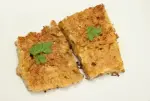

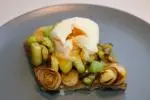

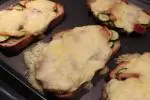



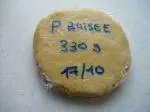
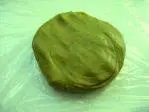
The 2 comments already posted on this recipe